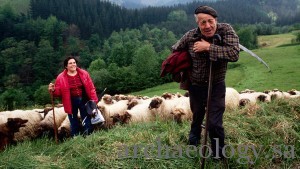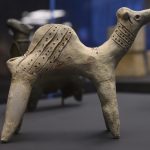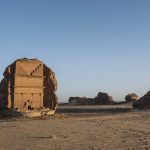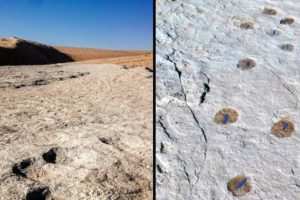
If you find yourself along the Atlantic coastal border between Spain and France, here are some phrases that might come in handy: Urte askotarako! (“Pleased to meet you!”), Eskerrik asko! (“Thank you!”), and Non daude komunak? (“Where is the toilet?”). Welcome to Basque Country, where many people speak a musical language that has no known relationship to any other tongue. Many researchers have assumed that Basque must represent a “relic language” spoken by the hunter-gatherers who occupied Western Europe before farmers moved in about 7500 years ago. But a new study contradicts that idea and concludes that the Basques are descended from a group of those early farmers that kept to itself as later waves of migration swept through Europe.
The great majority of Europeans speak languages belonging to the Indo-European family, which includes such diverse tongues as German, Greek, Spanish, and French; a smaller number speak Uralic languages like Finnish, Hungarian, and Estonian. But Basque stands truly alone; what linguists call a “language isolate.” This uniqueness is a source of pride among the nearly 700,000 Basque speakers, some of whom have called for the creation of an independent nation separate from Spain and France.
For scientists, however, Basque is a major unsolved mystery. In the 19th century, some anthropologists claimed that Basques had differently shaped skulls than other Europeans. Yet although that racial idea had been discredited by the 20th century, researchers have been able to show that the Basques have a striking number of genetic differences that set them apart from other Europeans. Variations in their immune cells and proteins include a higher-than-normal frequency of Rh-negative blood types, for example. Those findings led to the hypothesis that the Basques descended from early hunter-gatherers who had somehow avoided being genetically overwhelmed when farming spread into Europe from the Near East. But some recent studies have questioned just how genetically distinct the Basques really are.
In the new study, led by population geneticist Mattias Jakobsson of Uppsala University in Sweden, researchers sequenced the genomes of eight ancient skeletons found in the heart of Basque country, from El Portalón cave in northern Spain. The cave, located near other early human remains in the Atapuerca Mountains, was occupied almost continuously between 30,000 and 1000 years ago. It contains artifacts left by both hunter-gatherers and early farmers, as well as graves that were the product of deliberate burials. The interred skeletons—four female and four male including a male child—were directly radiocarbon dated to between 5500 and 3500 years ago, a span bridging the Chalcolithic (Copper Age) period and the Bronze Age. They were clearly farmers and not hunter-gatherers, based on their later age and on the typical artifacts, including pottery, that were found in the graves.
After extracting DNA from the skeletons and sequencing their genomes, the team compared their genetic profiles with more than a dozen from skeletons spanning the hunter-gatherer and early farming periods in Western and Central Europe—ranging from 8000 to about 5000 years ago. They also compared the ancient DNA with more than 2000 genomes from modern-day Europeans. As in earlier studies, the team found that the genomes of ancient European farmers represented a mixture of genes from earlier, indigenous hunter-gatherers and incoming agriculturalists. But today’s Basques turned out to be more closely related to the El Portalón farmers than to any other group in the study, including early hunter-gatherer genomes.
The findings are “surprising,” the team writes online today in the Proceedings of the National Academy of Sciences, given previous claims that the Basques represented a relic population of hunter-gatherers that had somehow remained isolated in Europe for thousands of years. If that were true, they would have been more closely related to ancient hunter-gatherers than the farmers found in the El Portalón cave. Therefore, Jakobsson says, “we can finally set aside this old story.”
So what accounts for the genetic distinctiveness of the Basques and the unique features of their language? Jakobsson says that there is indeed evidence that the Basques became isolated, but not during the initial spread of agriculture across Europe. Instead, their ancestors probably became isolated during subsequent waves of migration from central European and North African farmers that began about 5000 years ago. Modern-day Basques do not show genetic mixing from these later migrants, whose genes contribute between 10% and 25% of the genomes of non-Basques living in the Iberian Peninsula of Spain and Portugal today. “The El Portalon individuals, very similar to the Basques, do not show this additional genetic material,” Jakobsson says.
As for the Basque language, the team suggests that it might have been a descendant of a tongue spoken by early farmers, before the Indo-European language family became dominant on the continent. But the team concedes that it cannot entirely rule out the possibility that Basque still has its origins in a hunter-gatherer language that was retained and carried along as farming spread throughout Iberia.
Carles Lalueza-Fox, a geneticist at the University of Barcelona in Spain whose team has also been studying the spread of farming in Iberia, says that Jakobsson and his colleagues have got it right: “The Basques preserve the [genetic] signal” of the earliest farmers “more than other Iberians,” he says, and thus their “singularity” is owed to that agricultural heritage and not their hunter-gatherer ancestry.
By
Posted in Archaeology, Europe















